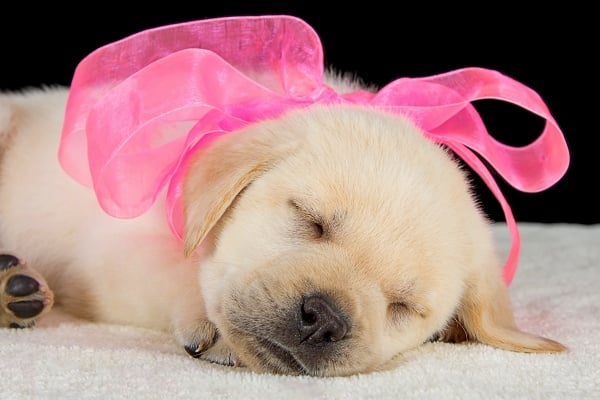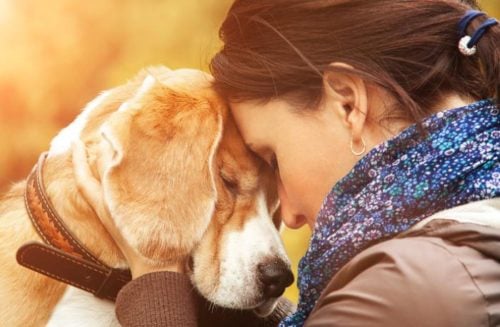Is your female dog acting more crazy than normal? Female dogs that aren’t spayed will eventually go into heat. If you’ve never had an experience with an intact female dog, you might find yourself confused about what is happening to your dog. When your dog goes into heat, she licks herself more often, there may be some bloody vaginal discharge from her private area, and her personality might seem a little off. You might become nervous along with your dog and this may end seem like a nightmare. What is going on?
In this article, you’ll learn the fundamentals of your dog’s heat cycle.

Table of Contents
- At what age do dogs reach sexual maturity?
- Signs that your dog is in heat
- What is “heat” and why does it affect dogs?
- Is a dog’s heat cycle different than a humans?
- What are the 4 stages of the dog heat cycle?
- Precautions to Take During a Dog’s Heat Cycle
- Conclusion
At what age do dogs reach sexual maturity?
6 – 12 months. Your little girl will reach sexual maturity at between 6 and 12 months of age. She’ll have her first heat and after that, she’ll go into heat every 6 months. A larger breed or giant breeds mature slower than small dogs. The ones we care for in our clinic like Great danes usually reach maturity closer to the 12 months of age where small dogs like a Pomeranian matures closer to the 6 month mark. As we’ve stated in our Dog Heat Cycle: A Comprehensive Guide for Pet Owners article, veterinary medicine and research show that spaying your female dog prior to her first heat is not only safe, but will eliminate the chance she will get mammary cancer. Since you are a responsible dog owner, please consider this if breeding is not something that you definitely are planning for.
Signs that your dog is in heat
We have consulted with many a pet parent on their dogs first estrus cycle when they bring their little girl into our vet clinic. Not surprisingly, they are usually looking for physical signs when her dog is “in season”. Unlike the human menstrual cycle, behavior changes are the first symptoms that your dog will start to show. It’s important to monitor your female dog’s behavior during her heat cycle. You may notice changes in her behavior such as:
- Increased restlessness
- Increased vocalization
- Increased need for affection
She may also show signs of aggression or anxiety. It’s essential to keep a close eye on her and provide a safe, comfortable space for her to rest.
What is “heat” and why does it affect dogs?
The reason your dog is acting crazy that is hard to bear is due to her reproductive cycle known as the “heat” cycle or estrus cycle. This process is a natural part of your dog’s reproductive system. The function of the heat cycle somewhat resembles a woman’s monthly menstruation, though it is slightly different and, luckily, dogs come in heat only twice a year.
Is a dog’s heat cycle different than a humans?

Yes. For humans, menstruation occurs after ovulation and only if the ova has not been fertilized. The menstrual fluid that is released is the shedding of the uterine wall that had built up in preparation for pregnancy. Dogs will have vaginal discharge to signal their are about to be receptive to mating. Dogs are considered “in heat” before ovulation, and their cycle actually makes them slightly anxious to mate, causing behavioral changes like restlessness.
What are the 4 stages of the dog heat cycle?
The complete cycle consists of four phases : Proestrus and Estrus, when your dog is referred to as being “in heat,” and Diestrus and Anestrus, when your dog isn’t in heat.
Don’t be confused about these fancy words. They all come from the Greek root “oistros” which means frenzy. The prefixes “pro”, “di”, and “an” mean before, second, and not accordingly. Thus the 4 stages of the dog heat cycle or estrus cycle is when your dog is almost in frenzy, in frenzy (no prefix), once again in frenzy, and not in frenzy.
- Proestrus or before being in frenzy lasts 7-10 days. This is the preparatory stage which gets your dog ready to be in heat. A red discharge from the vulva usually appears at this stage.
- Estrus or true heat lasts 5-10 days. This will likely be the most difficult part of the heat cycle for both of you. This is when ovulation occurs and the uterus is receptive to implantation. In the estrus stage, your dog will be extremely attracted (and attractive) to male dogs. Even if you consider your dog to be extremely well trained, she will find it difficult to listen to your commands in this stage. This is also the phase when your dog can become pregnant.
- Diestrus is the part of heat that lasts 10-140 days. This stage is responsible for sustaining pregnancy in the event that a successful mating occurs. As the prefix di- suggests, this is a second frenzy though your dog will not actually be frenzied during this time. The start of this stage will be evident when your dog refuses to “stand” for mating. No matter if a female has become pregnant or not, her body produces hormones to sustain the growth of her puppies which cease only when diestrus is over.
- Anestrus is the last part of the heat cycle that lasts 6 months or more. This is when her reproductive system takes a rest and gains strength to undergo the next heat cycle. This normally means your dog isn’t in heat and can last for several months. The cycle begins again and your dog will go into proestrus once more.
Each part of the heat cycle generates different hormones that influence your dog , working together to help make the miracle of the birth happen…or not.
Precautions to Take During a Dog’s Heat Cycle
To ensure your dog’s safety and comfort during her heat cycle, you can take several precautions, such as providing her with fresh water and keeping her in a clean, quiet space. You can also speak to your vet about options for managing your dogs heat cycle, such as hormone therapy.
This could be things such as spaying your male dog or keeping her in a secure location away from intact male dogs. You also want to be very careful when you walk her. Never take her off leash and be wary of any male dogs in the area. Hormonal urges are very powerful so please be very careful if you have to take her outside during her heat cycle to avoid an unwanted pregnancy.
Your dog is in heat, that is what’s going on. The best way to prevent this from happening is to spay your female pets, which is a reasonable thing to do if you do not plan on breeding your dog.
Women may understand female dogs in heat better, though human menstruation only distantly resembles heat in dogs. Photo: soloway.
Conclusion
So what now? If you have noticed some unusual behavior or discharge, your dog is likely at the stage of proestrus or estrus. You’ll have to be tough and hang in there though, because once started, the cycle cannot be interrupted. As mentioned before, the best option to prevent your dog from going into heat is to spay her. However, if heat has already started, you must wait for it to end before doing the spay surgery. In order to help you with the struggle in the meantime, here are several tips to help you on your way.
This article is a part of a series about dogs in heat.
Next up: At what age do dogs come in heat?
